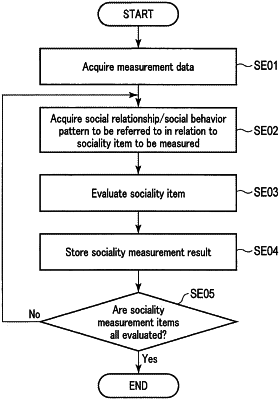| CPC G16H 10/60 (2018.01) [G06F 40/30 (2020.01); G10L 15/26 (2013.01); H04L 67/535 (2022.05); G16H 50/30 (2018.01); H04L 67/52 (2022.05)] | 12 Claims |

|
1. A medical information system comprising:
an information processing terminal used by a measurement target person; and
a medical information server external to the information processing terminal and communicating with the information processing terminal via a communications network,
the medical information server comprising:
a memory that stores at least a social relationship management table in which the measurement target person is associated with others in a social relationship, and a sociality item management table which stores sociality items as Quality of Life (QOL) indexes relating to sociality of the measurement target person in association with the social relationship and a behavior pattern; and
first processing circuitry configured to:
collect social behavior information about the measurement target person from the information processing terminal, the social behavior information including a daily sound of the measurement target person and a daily amount of exercise of the measurement target person, the first processing circuitry being configured to collect positional information as the social behavior information, collect an electronic mail as the social behavior information, collect call contents using a telephone as the social behavior information, or collect posted contents to a social networking service (SNS) as the social behavior information;
identify the social relationship between the measurement target person and the others, by using the social relationship management table and the collected social behavior information;
identify a behavior pattern of the measurement target person, by using the sociality item management table and the identified social relationship, the first processing circuitry being configured to identify the behavior pattern based on the positional information, identify the behavior pattern by analyzing a text of the electronic mail, identify the behavior pattern by analyzing a text of the call contents, or identify the behavior pattern by analyzing a text of the posted contents;
quantitatively measure a sociality item as a QOL index concerning sociality of the measurement target person by using the identified social relationship and the identified behavior pattern; and
generate a sociality measurement report by using a measurement result of the sociality item, wherein
the social behavior information is information relating to communication performed by the measurement target person with the others, and
the behavior pattern is information classified by emotion of the measurement target person; and
output circuitry configured to output the sociality measurement report, the information processing terminal comprising:
second processing circuitry configured to
acquire the daily sound via a microphone, and
transmit, via the communications network, the social behavior information including the acquired daily sound to the medical information server, wherein
the first processing circuitry
acquires a sound volume from the daily sound included in the transmitted social behavior information,
converts the daily sound into a text, and divides the text into words, and
identifies, based on the text, the sound volume, and a threshold value of the sound volume, a further detailed behavior pattern associated with emotion that is represented by the text, and
the memory stores measurement results of sociality items of a plurality of measurement target persons.
|